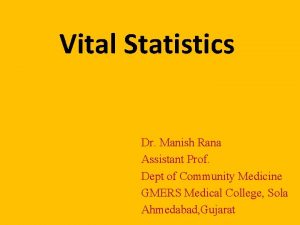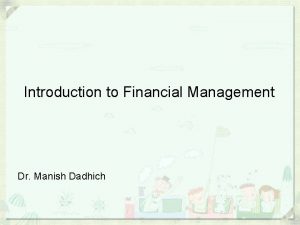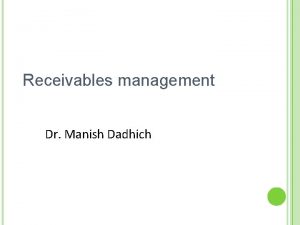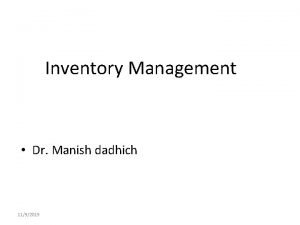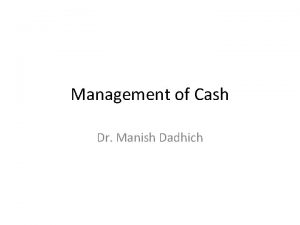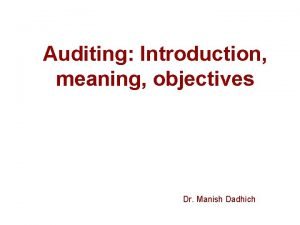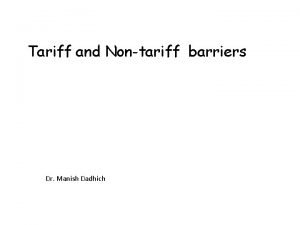Introduction to Portfolio Management Dr Manish Dadhich What










- Slides: 10

Introduction to Portfolio Management Dr Manish Dadhich

What is Portfolio? 1. Portfolio refers to invest in a group of securities rather to invest in a single security. 2. “Don’t Put all your eggs in one basket” 3. Portfolio management deals with the analysis of individual securities as well as with theory and practice of optimally combining securities into portfolios. 4. An investors who understands the fundamental and analytic aspects of portfolio management has a better chance of success. 5. Portfolio helps in reducing risk without sacrificing return.

Portfolio Management • Portfolio Management is the process of creation and maintenance of investment portfolio. • Portfolio management is a complex process which tries to make investment activity more rewarding and less risky.

Major tasks involved with Portfolio Management 1. Taking decisions about investment mix and policy 2. Matching investments to objectives 3. Asset allocation for individuals and institution 4. Balancing risk against performance

Phases of Portfolio Management Portfolio management is a process of many activities that aimed to optimizing the investment. Five phases can be identified in the process: 1. Security Analysis. 2. Portfolio Analysis. 3. Portfolio Selection. 4. Portfolio revision. 5. Portfolio evaluation. Each phase is essential and the success of each phase is depend on the efficiency in carrying out each phase.

1. Security Analysis. Security analysis is the initial phase of the portfolio management process. There are many types of securities available in the market including equity shares, preference shares, debentures and bonds. It forms the initial phase of the portfolio management process and involves the evaluation and analysis of risk return features of individual securities. The basic approach for investing in securities is to sell the overpriced securities and purchase under priced securities. The security analysis comprises of Fundamental Analysis and technical Analysis.

2. Portfolio Analysis: • A portfolio refers to a group of securities that are kept together as an investment. Investors make investment in various securities to diversify the investment to make it risk averse. A large number of portfolios can be created by using the securities from desired set of securities obtained from initial phase of security analysis. • By selecting the different sets of securities and varying the amount of investments in each security, various portfolios are designed. After identifying the range of possible portfolios, the risk-return characteristics are measured and expressed quantitatively. It involves the mathematically calculation of return and risk of each portfolio.

3. Portfolio Selection • During this phase, portfolio is selected on the basis of input from previous phase Portfolio Analysis. The main target of the portfolio selection is to build a portfolio that offer highest returns at a given risk. The portfolios that yield good returns at a level of risk are called as efficient portfolios. • The set of efficient portfolios is formed and from this set of efficient portfolios, the optimal portfolio is chosen for investment. The optimal portfolio is determined in an objective and disciplined way by using the analytical tools and conceptual framework provided by Markowitz’s portfolio theory.

4. Portfolio Revision • After selecting the optimal portfolio, investor is required to monitor it constantly to ensure that the portfolio remains optimal with passage of time. Due to dynamic changes in the economy and financial markets, the attractive securities may cease to provide profitable returns. These market changes result in new securities that promises high returns at low risks. In such conditions, investor needs to do portfolio revision by buying new securities and selling the existing securities. As a result of portfolio revision, the mix and proportion of securities in the portfolio changes.

5. Portfolio Evaluation • This phase involves the regular analysis and assessment of portfolio performances in terms of risk and returns over a period of time. During this phase, the returns are measured quantitatively along with risk born over a period of time by a portfolio. The performance of the portfolio is compared with the objective norms. Moreover, this procedure assists in identifying the weaknesses in the investment processes.

